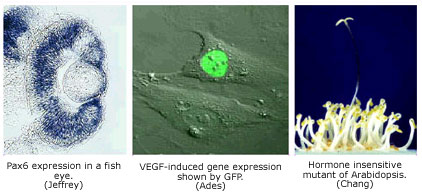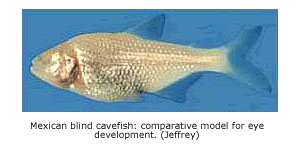|
|
|
|
Cell and Developmental Biology

The Cell and Developmental Biology specialization is an integral part of
the graduate program in Cell Biology and Molecular Genetics (CBMG).
Thus, all prospective students interested in Cell and Developmental Biology
should fill out the application form by entering CBMG as the graduate program
and Cell and Developmental Biology as the specialization.
Research labs in this specialization study cell and developmental processes
using single- and multi-celled model organisms including bacteria, cultured
cells, fruit flies, plants, and fish. Plant and animal development,
plant cell biology and physiology, signal transduction, and cellular immunology
are particular strengths of the faculty within this specialization.
Experimental approaches include light and electron microscopy, molecular
biology, genetics, and biochemistry. Resources available for cell
biological study within CBMG include a state-of-the-art light microscope
facility for fluorescence, confocal and deconvolution microscopy.
Ibrahim Z. Ades,
Professor and Chair of CBMG
Ph.D. University of California, Los Angeles, 1976. Cancer
biology and angiogenesis.
Eric
Baehrecke, Adjunct Associate Professor
Ph.D. University of
Wisconsin, Madison, 1992. Steroid regulation of gene expression,
differentiation, and programmed cell death during insect development.
Caren Chang, Associate
Professor
Ph.D. California Institute of Technology, 1988. Signal transduction
and hormonal signaling in Arabidopsis.
Marco
Colombini, Affiliate Professor
Ph.D., McGill University, 1974. Structure and mode of action
of membrane transport systems; molecular basis for voltage control
of channel-forming proteins.
Todd Cooke, Professor
Ph.D. Cornell University, 1979. Plant morphogenesis; development
processes in lower vascular plants; origins of biological form.
Kenneth
Frauwirth, Assistant Professor
Ph.D. University of California-Berkeley. T cell activation and peripheral
tolerance mechanisms; regulation of lymphocyte metabolism.
Eric O. Freed,
Adjunct Associate Professor
Ph.D. University of Wisconsin-Madison,
1990. Molecular biology of HIV-1 replication; retrovirus assembly
and release.
Elisabeth Gantt,
Professor
Ph.D. Northwestern University, 1958. Cell biology of the photosynthetic
apparatus and accessory pigments; physiology of algae.
Lian-Yong Gao, Assistant
Professor
Ph.D. University of Kentucky, 1999. Macrophage interaction with
intracellular bacteria; molecular and cell biology of Mycobacteria
evasion of host immune defense mechanisms.
William
Jeffery, Affiliate Professor and Chair of Biology
Ph.D. University of Iowa, 1971. Molecular and cellular mechanisms
of sensory organ development; evolution of development.
June Kwak, Assistant
Professor
Ph.D. Pohang University of Science and Technology, 1997. Guard cell ABA
and Ca2+ signal transduction/Single cell-type functional genomics.
Zhongchi Liu, Associate
Professor
Ph.D. Harvard University, 1990. Flower development in Arabidopsis.
Ian Mather,
Affiliate Professor
Ph.D. University College of North Wales, 1971. Expression
and function of mammary glycoproteins.
David Mosser,
Professor
Ph.D. North Carolina State University, 1983. Cell and molecular
biology of macrophages and dendritic cells; regulation of cytokine
gene expression; host defense response to intracellular pathogens.
Stephen
Mount, Associate Professor
Ph.D. Yale University, 1983. Selection of splice sites in
pre-mRNA splicing.
Wenxia Song, Associate
Professor
Ph.D. Kansas State University, 1991. Antigen transport and
signal transduction functions of the B cell antigen receptor.
Richard Stewart,
Associate Professor
Ph.D. University of Michigan, 1984. Molecular biology of sensory
systems and motility in bacteria.
Heven Sze, Professor
Ph.D. Purdue University, 1975. Membrane structure, function,
and biogenesis; regulation of solute transport; bioenergetics; proton-and
calcium-pumping ATPases in plants.
Stephen Wolniak,
Professor
Ph.D. University of California, Berkeley, 1979. Cell motility
and gametogenesis. Mechanisms involved in cell fate determination.

The graduate program in the Cell and Developmental Biology specialization
is designed to teach students to think critically, communicate effectively,
and develop the research skills required for a successful career as an
independent scientist. Both M.S. and Ph.D. students in this specialization
follow the first-year program for all entering CBMG graduate students,
including core courses, lab rotations, and seminars. After the first
year, an advisory committee helps each student to choose the advanced courses
that are appropriate for the student's research plans and career objectives.
The Admission to Candidacy Exam, in the third year, gives students the
opportunity to defend the objectives and intellectual foundations of their
dissertation research and to demonstrate an understanding of contemporary
cell and developmental biology. Subsequent to this exam, students
focus almost entirely on their research.
Advanced courses taught by faculty in the Cell and Developmental
Biology specialization include:
CBMG 610 Bioethics (Gantt)
CBMG 615 Membrane Biology (Sze)
CBMG 625 Genetic Approaches to Cell and Developmental Biology (Liu)
CBMG 627 Techniques in Microscopy (Wolniak)
CBMG 630 Advanced Cell Biology Laboratory (Gantt)
CBMG 640 Molecular Genetics of Plants (Chang)
CBMG 645 Advanced Microbial Genetics (Stewart)
CBMG 650 Genomics (Mount)
CBMG 660 Signal Transduction (Stewart)
CBMG 700 Advanced Immunology (Song)
CBMG 705 Advanced Microbial Physiology (Stewart)
CBMG 745 Developmental Mechanisms in Plant Evolution (Cooke)
Several other departments on the campus offer advanced courses that
may be relevant to the research interests of students in this specialization.
In addition, graduate students have a good opportunity to improve their
communication and interaction skills by serving as teaching assistants
for two semesters, as well as by presenting journal papers and their research
in formal and informal settings throughout their graduate training.
The vast majority of our graduates move on to successful careers in universities,
research institutions, or biotechnology companies.
|